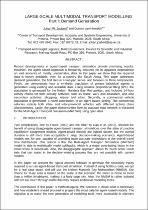JavaScript is disabled for your browser. Some features of this site may not work without it.
- ResearchSpace
- →
- Research Publications/Outputs
- →
- Conference Publications
- →
- View Item
| dc.contributor.author |
Joubert, JW

|
|
| dc.contributor.author |
Van Heerden, Quintin

|
|
| dc.date.accessioned | 2013-09-30T08:04:29Z | |
| dc.date.available | 2013-09-30T08:04:29Z | |
| dc.date.issued | 2013-07 | |
| dc.identifier.citation | Joubert, J.W and Van Heerden, Q. 2013. Large-scale multimodal transport modelling. Part 1: Demand generation. In: 32nd Annual Southern African Transport Conference (SATC 2013), CSIR International Convention Centre, Pretoria, South Africa, 8-11 July 2013 | en_US |
| dc.identifier.uri | http://hdl.handle.net/10204/6963 | |
| dc.description | 32nd Annual Southern African Transport Conference (SATC 2013), CSIR International Convention Centre, Pretoria, South Africa, 8-11 July 2013 | en_US |
| dc.description.abstract | Recent developments in agent-based transport simulation provide promising results. However, the agent-based approach is frequently criticized for its apparent dependence on vast amounts of, mostly unattainable, data. In this paper we show that the required data is mostly available, even for a country like South Africa. This paper addresses demand generation, the first step in a two-part series, and focuses on three components. Firstly, we demonstrate how a synthetic population of private individual agents is generated using existing and available data. Using iterative proportional fitting (IPF), the population is generated for the Nelson Mandela Bay Metropolitan, and includes 24-hour activity chains for both primary activities such as home, work and education, and also secondary activities: shopping, leisure and other. Secondly, a commercial vehicle population is generated, a novel contribution in an agent-based setting. The commercial vehicles include both intra- and inter-provincial vehicles with different activity chain characteristics. Lastly, the paper demonstrates how an accurate road network is extracted for the Multi Agent Transport Simulation (MATSim) using open data. | en_US |
| dc.language.iso | en | en_US |
| dc.publisher | SATC 2013 | en_US |
| dc.relation.ispartofseries | Workflow;11252 | |
| dc.subject | Transport modelling | en_US |
| dc.subject | Nelson Mandela Bay Metropolitan | en_US |
| dc.subject | Multi Agent Transport Simulation | en_US |
| dc.subject | MATSim | en_US |
| dc.title | Large-scale multimodal transport modelling. Part 1: Demand generation | en_US |
| dc.type | Conference Presentation | en_US |
| dc.identifier.apacitation | Joubert, J., & Van Heerden, Q. (2013). Large-scale multimodal transport modelling. Part 1: Demand generation. SATC 2013. http://hdl.handle.net/10204/6963 | en_ZA |
| dc.identifier.chicagocitation | Joubert, JW, and Q Van Heerden. "Large-scale multimodal transport modelling. Part 1: Demand generation." (2013): http://hdl.handle.net/10204/6963 | en_ZA |
| dc.identifier.vancouvercitation | Joubert J, Van Heerden Q, Large-scale multimodal transport modelling. Part 1: Demand generation; SATC 2013; 2013. http://hdl.handle.net/10204/6963 . | en_ZA |
| dc.identifier.ris | TY - Conference Presentation AU - Joubert, JW AU - Van Heerden, Q AB - Recent developments in agent-based transport simulation provide promising results. However, the agent-based approach is frequently criticized for its apparent dependence on vast amounts of, mostly unattainable, data. In this paper we show that the required data is mostly available, even for a country like South Africa. This paper addresses demand generation, the first step in a two-part series, and focuses on three components. Firstly, we demonstrate how a synthetic population of private individual agents is generated using existing and available data. Using iterative proportional fitting (IPF), the population is generated for the Nelson Mandela Bay Metropolitan, and includes 24-hour activity chains for both primary activities such as home, work and education, and also secondary activities: shopping, leisure and other. Secondly, a commercial vehicle population is generated, a novel contribution in an agent-based setting. The commercial vehicles include both intra- and inter-provincial vehicles with different activity chain characteristics. Lastly, the paper demonstrates how an accurate road network is extracted for the Multi Agent Transport Simulation (MATSim) using open data. DA - 2013-07 DB - ResearchSpace DP - CSIR KW - Transport modelling KW - Nelson Mandela Bay Metropolitan KW - Multi Agent Transport Simulation KW - MATSim LK - https://researchspace.csir.co.za PY - 2013 T1 - Large-scale multimodal transport modelling. Part 1: Demand generation TI - Large-scale multimodal transport modelling. Part 1: Demand generation UR - http://hdl.handle.net/10204/6963 ER - | en_ZA |






